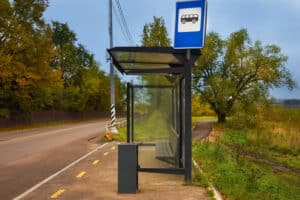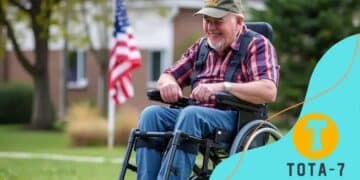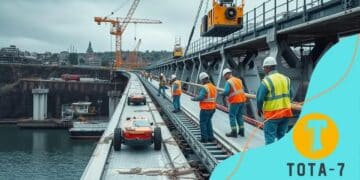Universal basic mobility programs launch in transit deserts

Universal basic mobility programs in transit deserts aim to provide equitable access to transportation, improving connectivity and opportunities for underserved communities through innovative solutions and community engagement.
Universal basic mobility programs launch in transit deserts are reshaping how underserved communities access transportation. Ever wondered how these initiatives can change lives and create opportunities? Let’s explore this transformative movement.
Understanding universal basic mobility
Understanding universal basic mobility is crucial as cities aim to provide equitable transportation solutions. These programs are designed to ensure that everyone, regardless of their economic status, can access reliable and affordable transportation options. This is especially important in transit deserts, where traditional public transportation services may be lacking.
What is Universal Basic Mobility?
Universal basic mobility refers to the concept that all individuals should have the right to access transportation. This notion extends beyond simply having a bus stop nearby; it encompasses the quality, affordability, and reliability of transportation services. By prioritizing these elements, cities can foster greater economic opportunities and improve overall quality of life.
Key Elements of Universal Basic Mobility
- Accessibility: Ensuring transportation options are available to all residents.
- Affordability: Reducing costs for users to promote use of public transport.
- Reliability: Providing consistent and dependable service that meets community needs.
- Inclusivity: Taking into account the diverse needs of the population, including those with disabilities.
In many urban areas, there are significant challenges that hinder the implementation of these programs. Issues such as funding, infrastructure, and public acceptance can lead to obstacles that need to be addressed. However, cities that embrace universal basic mobility can potentially see a wide range of benefits, including decreased traffic congestion and lower greenhouse gas emissions.
Furthermore, examples of successful implementations can inspire other regions to consider similar initiatives. Cities like Seattle and Los Angeles are experimenting with various forms of mobility solutions, aiming to bridge the gap in underserved communities. By showcasing these success stories, advocates for universal basic mobility can build momentum and highlight effective strategies that can be replicable.
Universal basic mobility is more than just a transportation initiative; it is a pathway to social equity. By ensuring that everyone has access to transportation, cities can empower individuals and foster stronger, more connected communities.
The impact on transit deserts

The impact of transit deserts is profound, affecting millions of people in urban and rural areas. When public transportation is inadequate, residents face significant challenges in accessing jobs, education, and healthcare. This situation creates a cycle of disadvantage that is hard to break.
Defining Transit Deserts
A transit desert is an area where public transportation options are extremely limited or non-existent. These regions often lack the infrastructure necessary for effective mobility, which makes it difficult for residents to travel to basic services. Many people who live in transit deserts rely on personal vehicles, which can be a burden due to costs and maintenance.
Consequences of Living in Transit Deserts
- Limited job opportunities, as individuals may struggle to commute to work.
- Reduced access to education, making it challenging for students to reach schools or colleges.
- Difficulty accessing healthcare services, leading to unaddressed health issues.
- Increased isolation, particularly for the elderly or those without vehicles.
The lack of reliable transportation also contributes to higher levels of pollution and traffic congestion. As more residents buy cars out of necessity, cities face increased emissions and gridlock. Addressing these environmental and social issues is imperative for community health.
Several cities are beginning to tackle the issue of transit deserts through innovative solutions. These include enhanced bus routes, on-demand shuttle services, and partnerships with ride-sharing companies. By investing in these transportation models, communities can improve access and create equitable opportunities for all residents.
Understanding the impact of transit deserts highlights the urgency of implementing universal basic mobility programs. Improving transit access is essential for fostering inclusive communities and ensuring that no one is left behind.
Key programs making a difference
Many innovative programs are emerging to address the challenges posed by transit deserts. These initiatives aim to improve mobility and accessibility for everyone, ensuring that underserved communities can benefit from reliable transportation. Let’s examine some of the key programs that are making a difference.
Community Bus Programs
Community bus programs provide essential transport services in areas where traditional public transit is limited. These services often include scheduled routes that connect neighborhoods to important locations like grocery stores, schools, and health clinics. They can be adjusted based on community needs, ensuring that residents have the mobility they require.
On-Demand Ridesharing Services
Another approach gaining popularity is on-demand ridesharing, where residents can request a ride through a mobile app. This service is particularly beneficial for those who do not have access to a car. Some cities partner with rideshare companies to offer subsidized fares for low-income residents, helping to bridge the gap in transit deserts.
Public-Private Partnerships
- Collaboration between government and private sectors fosters innovative mobility solutions.
- These partnerships can increase funding for public transport improvements.
- They also allow for shared resources, making services more efficient.
Successful examples of public-private partnerships can be found in cities like Austin, Texas, where local agencies work with private companies to expand transportation options. Such approaches not only enhance existing infrastructure but also promote sustainable practices, ensuring that urban growth does not lead to more transit deserts.
Additionally, some programs focus on equity by providing tailored transportation options for specific demographics, such as the elderly or people with disabilities. These initiatives are crucial in creating a more inclusive transit environment, allowing everyone to participate fully in their community.
As cities continue to innovate, the integration of technology and community needs will play a vital role in eliminating transit deserts. With the right mix of programs, we can create a future where everyone has access to the mobility they need.
Challenges faced by mobility initiatives
Mobility initiatives aimed at improving access in transit deserts face several challenges that can hinder their success. Understanding these obstacles is key to creating effective solutions and achieving equitable transportation.
Funding Limitations
One significant challenge is securing adequate funding. Many cities struggle to find the resources needed to launch and maintain mobility programs. Without stable financial support, programs can fall short of their goals or face termination.
Infrastructure Issues
The existing infrastructure often inadequately supports new mobility initiatives. Many areas have outdated roads or lack proper sidewalks and bike lanes, making it difficult for residents to use alternative transportation options like walking or cycling. These barriers can limit the effectiveness of programs designed to promote sustainable transit.
Community Engagement
- Building trust with local communities is essential for successful mobility initiatives.
- Programs must address the specific needs of residents to gain acceptance.
- Without community buy-in, initiatives can fail to attract users.
Gaining community support is not always easy. Many residents may be skeptical of new programs, especially if they feel their needs have not been considered. Engaging with the community through meetings and surveys can help tailor initiatives to meet local demands.
Resistance to change is another barrier. Some individuals may prefer existing transportation modes, even if they are inefficient. Changing transportation habits takes time and requires effective communication about the benefits of new solutions.
In addition, collaboration between different government agencies can be challenging. Many mobility initiatives require coordination across various departments, including transportation, public health, and urban planning. Misalignment of goals among these entities can delay or derail progress.
Future of mobility in underserved areas
The future of mobility in underserved areas is shifting towards innovative solutions that prioritize accessibility and sustainability. As cities recognize the challenges faced by transit deserts, they are beginning to implement new strategies to enhance transportation options for all residents.
Technological Integration
The integration of technology plays a crucial role in transforming mobility. Smart transportation systems can help to coordinate multiple services, making it easier for users to navigate their options. For example, apps that consolidate bus, bike, and rideshare information can provide real-time data, helping people make informed decisions. This creates a more seamless experience for users in underserved areas.
Community-Centric Mobility Solutions
Future mobility solutions will increasingly focus on community needs. Local governments are encouraged to involve communities in the planning process, ensuring that new initiatives align with their specific demands. By engaging residents through surveys and public discussions, cities can better understand what transportation options will be most effective.
- Mobile applications connecting users with local transport services.
- Community-driven planning to ensure the success of new initiatives.
- Partnerships with nonprofits to provide subsidized transport options.
Another promising development is the expansion of micro-mobility options, such as electric scooters and bicycle-sharing programs. These alternatives provide flexible and affordable transportation solutions, making it easier for residents to travel shorter distances. They can effectively link users to larger public transport networks, thus easing congestion in urban areas.
Moreover, electric vehicles (EVs) and sustainable public transport options are gaining traction, reducing the overall carbon footprint. Governments are investing in charging infrastructure for EVs and exploring solutions such as electric buses for public transit. This shift towards greener options is essential for building a sustainable future.
Overall, the future of mobility in underserved areas is not just about transportation; it is about creating equitable access that enriches lives and fosters community connections. By focusing on innovative, technology-driven, and community-centered strategies, cities can dismantle the barriers present in transit deserts.
FAQ – Frequently Asked Questions about Mobility in Underserved Areas
What are transit deserts?
Transit deserts are areas where public transportation options are extremely limited or nonexistent, making it difficult for residents to access jobs, healthcare, and education.
How can technology improve mobility in underserved communities?
Technology can enhance mobility by providing real-time information on public transport, integrating different transportation services, and offering apps for ridesharing and trip planning.
Why is community engagement important in mobility initiatives?
Community engagement helps ensure that mobility programs address the specific needs of residents, increasing acceptance and usage of new transportation options.
What role do partnerships play in improving mobility?
Partnerships between public agencies and private companies can increase funding, resources, and innovative solutions, allowing for a more effective addressing of mobility challenges.





